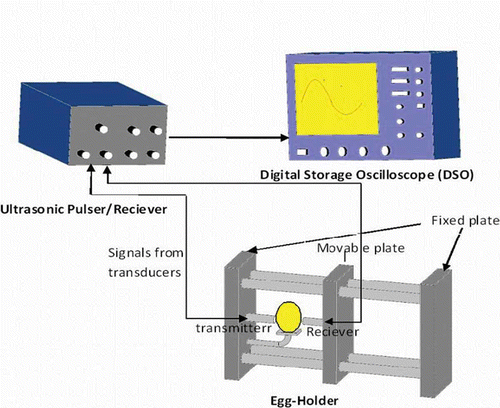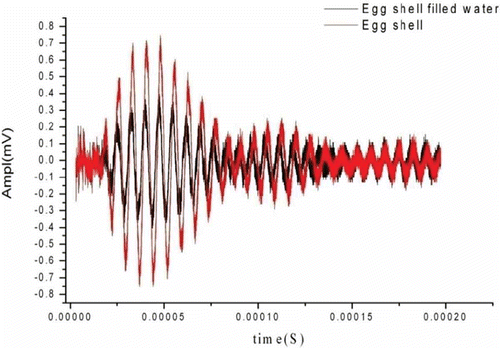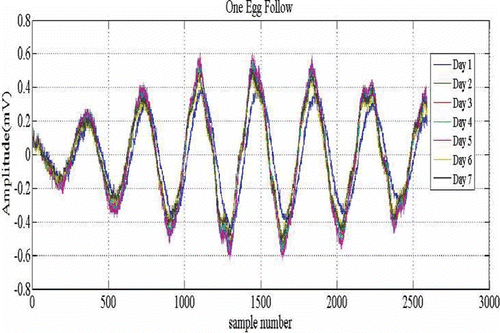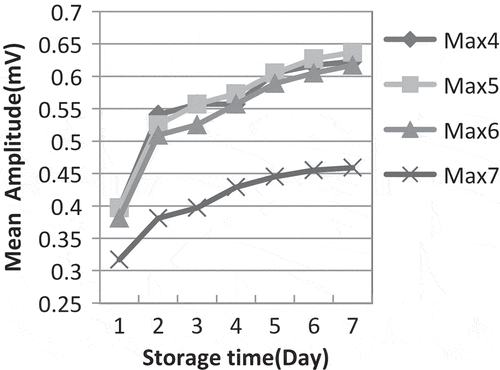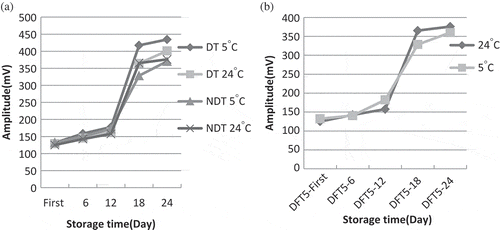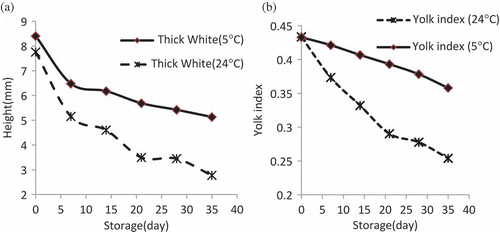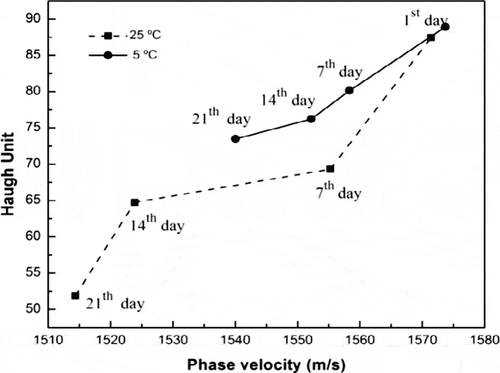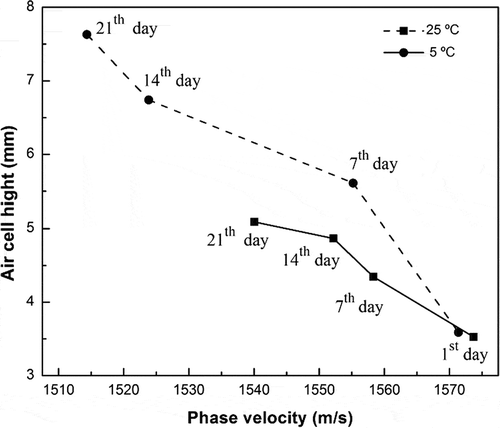Abstract
A non-destructive ultrasound based method was used to develop a model for poultry egg freshness assessment. The proposed model can predict the Haugh unit, albumen thickness, air-cell height, and a number of other egg quality parameters by computing the ultrasound phase velocity within the egg material. For this purpose, the effect of the storage time on the ultrasound phase velocity within the poultry eggs together with the peak values of the transmitted ultrasound signals in the time and frequency domains were considered as indicators of egg freshness. Tests were conducted on eggs that were stored for five weeks in different storage conditions. The computed parameters were used to develop different models to predict the number of storage days for the egg samples. The results showed that the amplitude of the main peaks of the ultrasound signal in the time domain increased by the number of storage days. Moreover, there was a significant difference between the mean values of the phase velocities obtained at different times during the storage period. Comparing the results obtained for the eggs kept at the room temperature to those refrigerated showed that these variations were more significant for the eggs kept at room temperature.
INTRODUCTION
Over the past few decades, non-destructive high power ultrasound technique has been an efficient tool for food quality assessment. It has been found that the phase velocity of the ultrasound signal transmitted through a material is related to the physical and mechanical properties of the substance and can be used as a quality assessment parameter of food materials.[Citation1CitationCitationCitationCitation−Citation6] Food quality assessment using ultrasound based techniques is often preferred to other techniques because of its lower cost, portability of the device, and non-destructive nature. Moreover, the low-energy ultrasound signals used in non-destructive testing (NDT) have no negative effect on the physical and mechanical properties of the biomaterials.
Various studies have reported that “the poultry egg is recognized as a rich source of nutrients which is essential for maintaining human health.”[Citation7] Eggs are a valuable food source, and have long been consumed as part of daily diets throughout the world. Freshness assessment of poultry eggs which is highly correlated with the levels of its proteins, minerals, and vitamins is a crucial task in the food industry. The aging process of eggs depends on the storage conditions such as storage temperature and humidity. Toussant and Latshaw[Citation8] claimed that the most important visible physical change in the egg material during the storage period is the increase in the air-cell volume, mainly due to the loss of water and CO2 through the egg shell, and also changes related to the aging of the albumen and yolk. The air-cell volume developed immediately after laying by separation of two shell membranes.[Citation8] Thinning in the whites of the poultry eggs during storage is also a well-known phenomenon. It was reported that about 67% of an egg’s weight is related to the albumen content (egg whites).[Citation7] Egg whites become thinner by the egg aging due to the changes in the protein characteristics. During storage, thick albumen progressively liquefies and becomes thinner, this is why fresh eggs broken into a plate sit tall and firm while older ones tend to spread out. The main reason for this phenomenon is changes in the complex lysozyme–ovomucine which is caused by the PH increase during the storage period.[Citation8,Citation9]
Various methods have been developed for non-destructive determination of egg freshness in the past. One such technique is the candling inspection method. Candling is a tedious and subjective method and is not a robust method to ensure egg quality. In comparison, a non-destructive ultrasound based method is an efficient tool for egg quality assessment. It has been shown that there is a meaningful correlation between the phase velocity of ultrasound and the physical and mechanical properties of the egg material. The advantages of this method motivated the authors to develop a quantitative technique to differentiate fresh commercial eggs from aged ones.[Citation10] The proposed method calculated the parameters related to the ultrasound transmission through the egg material, such as the phase velocity and the amplitude of the transmitted signal in time and frequency domains, and related them to such traditionally used egg quality related parameters as the Haugh unit, albumen thickness, air-cell height, and some other parameters of commercial poultry eggs.
MATERIALS AND METHODS
Sample Preparation
Tests were carried out on 300 medium-sized commercial eggs collected from 33-weeks-old Boris Brown hens in October 2008 from the Kei farm (Kyoto, Japan) on the day the eggs were laid. On arrival to the laboratory, 50 eggs were analyzed, and the rest were divided into two groups. One group was kept at 5°C and a relative humidity of 75%; the other group was kept at 24 ± 1°C and a relative humidity of 40%. The eggs were first submitted to NDT which was followed by destructive analysis. After every six days, 25 eggs from each group were selected for analysis. This was repeated for five weeks during the storage period. The eggs which were stored at 5oC were allowed to warm up to room temperature (24°C) before the NDT. First, the eggs were individually inspected and the cracked ones were discarded. Ultrasonic NDT was carried out in parallel with the eggs from the two groups every week.
Theory of Ultrasonic Technique
Ultrasound uses interaction between high-frequency sound waves and the medium through which it travels. This can give information about the composition, structure, and dimensions of the medium (egg material). Physical properties of egg material have a direct impact on the phase velocity of ultrasound propagating through the egg material. For this study an experimental configuration was arranged where continuous wave ultrasound technique was employed to measure the phase velocity within the egg material (). The experimental configuration consisted of the measurement chamber containing the sample (the poultry egg), the transmitter-receiver system, the ultrasound probes, and a digital oscilloscope (DSO). The DSO has a maximum sampling rate of 2.5 GigaSamples/sec, which was appropriate for the current study. The ultrasonic system is a high-intensity system with a frequency of 150 kHz (model AE-901U, NF Electronic Instruments, Japan). This system used a set of probes arranged to measure the ultrasonic signal transmitted and received over short distances. Eggs were fixed between the four rods of the egg holder, and the probes that were attached to the eggs during the measurements. This method eliminates any relative motion between the probes and egg. Data was recorded and illustrated using the DSO at specific time intervals with sampling rate 2.5 G samples/sec. Non-destructive ultrasound testing was carried out on 25 eggs at room temperature and 25 refrigerated ones as the control group.
Ultrasonic Characterization of Egg Materials
Since any air gap between the ultrasonic transducer and the sample to be tested can prevent ultrasound wave from entering the material, a coupling material (special medical ultrasonic gel) was used between the transducer and the sample. Ultrasonic velocity is one of the key acoustic parameters in non-invasive testing of biomaterial. The most commonly used parameters of ultrasound in quality assessment of the biomaterials are the velocity of the ultrasound wave inside the material and its attenuation rate. Ultrasonic phase velocity can be uniquely determined from the phase of the ultrasound signal at a specified frequency. The Fast Fourier Transform (FFT) was employed to demonstrate the ultrasound signal in the frequency domain. This will be described in the next section, an effective phase detection method in the frequency domain was used to determine the phase velocity. In the experiments it was assumed that the eggshell thickness is uniform and similar for all eggs.
Theoretical
Ultrasonic analysis of egg quality relies on establishing a relationship between the ultrasonic signal properties when passed through the egg material and the material’s composition. The experiments showed that the energy of the transmitted ultrasound wave is very sensitive to the thickness of the eggshell and its curvature. On the other hand, the phase velocity of sound is a more robust parameter that is not affected very much by eggshell thickness or curvature. In this study, a combination of theoretical and empirical approaches was used to establish a relationship between the phase velocity of ultrasound and the composition of poultry egg material. Since ultrasound propagation velocity is altered during the egg deterioration, it can be used as a quality-assessment method. For this purpose, it is important to understand the interaction between ultrasound and the eggshell to develop a mathematical model for measuring the phase velocity of ultrasound within the eggshell. It was previously shown that the phase velocity difference between the aged and fresh eggs at different storage conditions when compared to the phase velocity obtained from the egg shell filled with distilled water as a reference demonstrates meaningful differences. Hence, the phase difference ( ) between each signal and the reference signal of the water-filled eggshell can be a good indicator for assessing egg freshness. In this study, signals from eggshells filled with distilled water and poultry eggs were compared and the phase difference was determined (). Phase velocity was then computed based on the phase difference as follows:[Citation10]
Standard Destructive Tests
Commonly used destructive tests were used to validate the ultrasound-based results. The common quality parameters considered to characterize the eggs’ quality during the storage period are: duration of storage (days), air-cell height (mm), thick albumen height (mm), Haugh unit, weight loss (g), diameter and height of the yolk (mm), and yolk index (YI). The thick albumen height was calculated as the average of three measurements taken at three different locations, each about 10 mm from the yolk border, using a tripod digital caliper. The air-cell height was measured as the distance from the base of the shell to the membrane at three equidistant points as well as the middle point of the membrane. The Haugh unit was calculated by means of the Haugh formula:[Citation11]
Signal Processing
The phase difference between the signals recorded after transition through a normal egg and an eggshell filled with distilled water are shown in . For each signal, phase velocity of the recorded ultrasound signals was calculated for both time and frequency domains. Variations in the signals as a result of aging during different storage periods and at different temperatures were investigated for all stored eggs. Transformation of the signals from the time domain to the frequency domain was performed using FFT. For this purpose, the ultrasound signal that was recorded each day from one sample egg over a period of one week at laboratory conditions was used. In this method one egg is fixed between two probes at room temperature, i.e., 24 ± 1°C, and 40% relative humidity (). shows example signals taken from one sample egg for seven consecutive days after laying. In these signals the first four maxima of each signal are considered and followed in all seven signals. shows that the peaks of all seven signals have increased during the storage time. The main cause of this phenomenon is changes in the density of the egg liquid due to the liquefaction (thinning) procedure of the thick white. This decreases signal attenuation within the egg material. The amplitude of the first five peaks of each signal is used in all measurements. Based on these preliminary results, the main experiments were done in more detail at various storage conditions. The experiments were performed using both destructive testing (DT) and NDT. To increase the accuracy of the tests, the contact point of the probe on the egg shell was marked to perform the second test exactly on the marked point. After the final NDT, the egg was broken and the destructive test was performed.
Egg Quality and the Maximum Signal Peak in Time Domain
The same test was carried out on the 25 eggs stored at room-temperature as well as the refrigerated ones at different time intervals. The test was also conducted on the eggs material after destruction. , shows the average value of the amplitude of the fourth peak of the ultrasound signal calculated for 25 eggs at different time intervals. As seen, this parameter increases by time. The main cause of this behavior is attributed to the changes in the egg-liquid density; especially liquefaction of thick white to thin white as the storage time increased.
Egg Quality and the Maximum Frequency Domain Components
Since the amplitude of the signal in the time domain is under the influence of the measurement noise, in this section a frequency domain analysis was performed to reduce the noise effect in the calculations. Applying the DFTFootnote1 to the time domain signals the frequency components of the signals are calculated. Considering the fact that the main peak of the signals in the frequency domain corresponds to the ultrasound signal itself, therefore using the amplitude of this peak is a kind of frequency domain filtering the signal and causes the researchers’ calculations to be minimally affected by the measurement noise. shows the average value of the amplitude of the main peak of the ultrasound signal in the frequency domain calculated for 25 eggs at different time intervals (over six days). As seen, this parameter also increases by time as it was expected from the time domain analysis.
RESULTS AND DISCUSSION
For assessment of the proposed method four parameters: phase velocity, air-cell height, Haugh unit, and YI were calculated through both destructive and non-destructive methods. Mean values of these parameters were measured for each sample at different storage conditions ( and ). YI, thick albumen height, and the consequent Haugh unit significantly decreased from the first to fifth week. Also, the air-cell height significantly increased as the eggs aged, for both groups stored in room temperature condition and in the refrigerator. and show the decreasing phase velocity in parallel to decrease in the Haugh unit. shows that the decrease in the phase velocity of ultrasound in the egg material is greater for eggs stored at the room temperature compared to the refrigerated eggs, mainly due to the changes in proteins (as one of the building material in thick white) with aging. The main reason is that the amino acid based proteins, which are one of the building materials for thick whites, are influenced by the aging of the eggs. This means that the ultrasound velocity in hen’s egg whites depended more on the eggs’ thermal history in storage than on the humidity of the storage conditions ( and ).
Figure 7 Average phase velocity calculated for 25 (a) fixed NDT (b) and control over different days.

As it was expected, albumen height decreased as the eggs aged. At this point, the presumption was that quality relates to the functionality of albumen. Ovomucin which is extremely viscous is the dominant factor for determining the height of albumen.[Citation7] Although it is not fully understood, the functional albumen height during storage, correlation phase velocity, and albumen height (Haugh unit) are good indicators of egg freshness. It was found that phase velocity was more affected by temperature than by storage time. In other words, storage temperature is the dominant factor for egg freshness. This phenomenon can be related to viscoelasticity of thick whites. The results of this research showed that quality measurements based on albumen and air-cell height have a good correlation with phase velocity.
CONCLUSIONS
The ultrasound technique used in this study is able to predict the main quality indices of egg freshness with considerable accuracy. Ultrasonic signals propagated through the poultry eggs were used to find out phase velocity at both room and refrigerator temperatures. Moreover, signal processing was carried out for the time and frequency domains. Observing four maximum peaks of each signal (time domain) showed that the signal peak increased as the eggs aged. From this pattern a simple trend of signals was seen. In the frequency domain, amplitude of DFT increased at both storage conditions (room and refrigerator) with increasing storage time. DT was carried out in parallel with NDT for each egg from the two groups every six days. Both the Haugh unit and YI decreased during storage over five weeks at both storage conditions, which indicated a deterioration of quality. It was also observed that during the same period the air-cell height increased. Results showed that average value changes in phase velocity during storage were similar to the changes in the Haugh unit and air-cell height during the same period. This can be related to the exchange of water between the yolk and the thick white during storage. It seems that the phase velocity is affected not only by viscoelasticity but also by thick-white density. More studies need to be performed focusing on the relation between phase velocity and viscoelasticity parameters of egg liquid (thick white) within aging eggs. However, the availability and low cost can be considered as great advantages for ultrasonic testing.
ACKNOWLEDGMENT
The authors would like to thank the laboratory of Agriculture Process Engineering, Kyoto University for their technical support.
Notes
2. 1Discrete Fourier transform
REFERENCES
- Abbott, J.A.; Lu, R.; Upchurch, B.L.; Stroshine, R.L. Technology for non-destructive quality evaluation of fruits and vegetables. Horticulture Review 1997, 20, 1–120.
- Jayasooriya, S.D.; Bhandari, B.R.; Torley, P.; D’Arcy, B.R. Effect of high power ultrasound waves on properties of meat: A Review. International Journal of Food Properties 2007, 10, 911–922.
- Knorr, D.; Zenker, M.; Heinz, V.; Dong-Un, L. Application and potential of ultrasonic in food processing. Trend in Food Science and Technology 2004, 15, 261–266.
- Mizrach, A.; Maltz, E.; Ignat, T. Detection fertilized egg by ultrasonic methods. CIGR International Conference; Book of Abstracts, Beijing, China, October 11–14, 2004.
- Povey, M.J.W.; Wilkinson, C. Application of the ultrasonic pulse echo technique to egg albumen quality testing: A preliminary report. British Poultry Science 1980, 21, 489–495.
- Povey, M.J.W.; Mason, T. Ultrasound in Food Processing, Blackie Academic and Professional: London, 1998.
- Shrimpton, D.H. The nutritive value of eggs and their dietary significance. In: Egg Quality-Current Problems and Recent Advances; Wells, R.G.; Belyavin C.G.; Eds.; Butterworth, Toronto, 1987.
- Toussant, M.J.; Latshaw, J.D. Ovomucin content and composition in chicken eggs with different interior quality. Journal of the Science of Food and Agriculture 1999, 79, 1666–1670.
- Meszaros, L.; Horti, K.; Farkas, J. Changes of hen eggs and their components caused by non-thermal pasteurizing treatments I. Gamma irradiation of shell eggs. Acta Aliment 2006, 35, 229–236.
- Aboonajmi, M.; Akram, A.; Nishizu, T.; Kondo, N.; Setaredan, S.K. An ultrasound based technique for determination poultry egg quality. Research in Agricultural Engineering 2010, 56, 26–32.
- Haugh, R.R. A new method for determining the quality of an egg. US Egg Poultry 1937, 39, 27–49.
- Funk, E.M. The relation of the yolk index determined in natural position to the yolk index, as determined after separating the yolk from the albumen. Poultry Science 1948, 27, 367.

